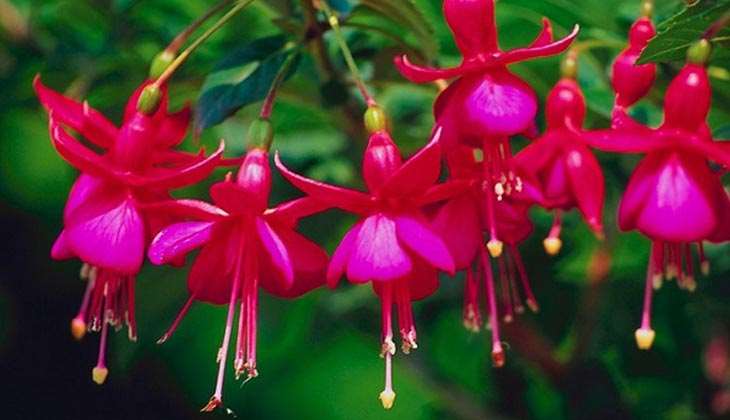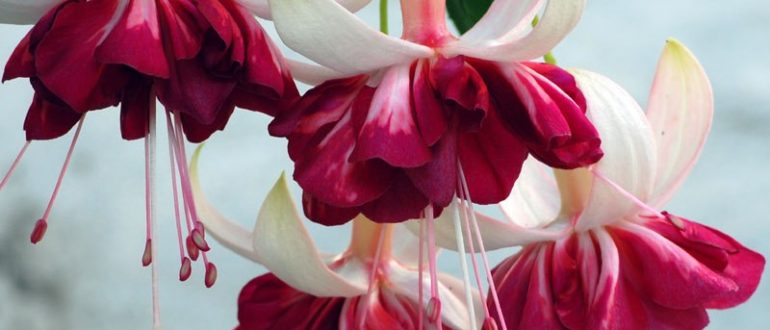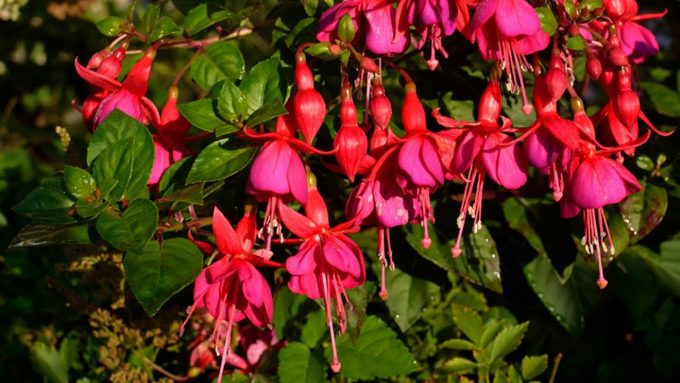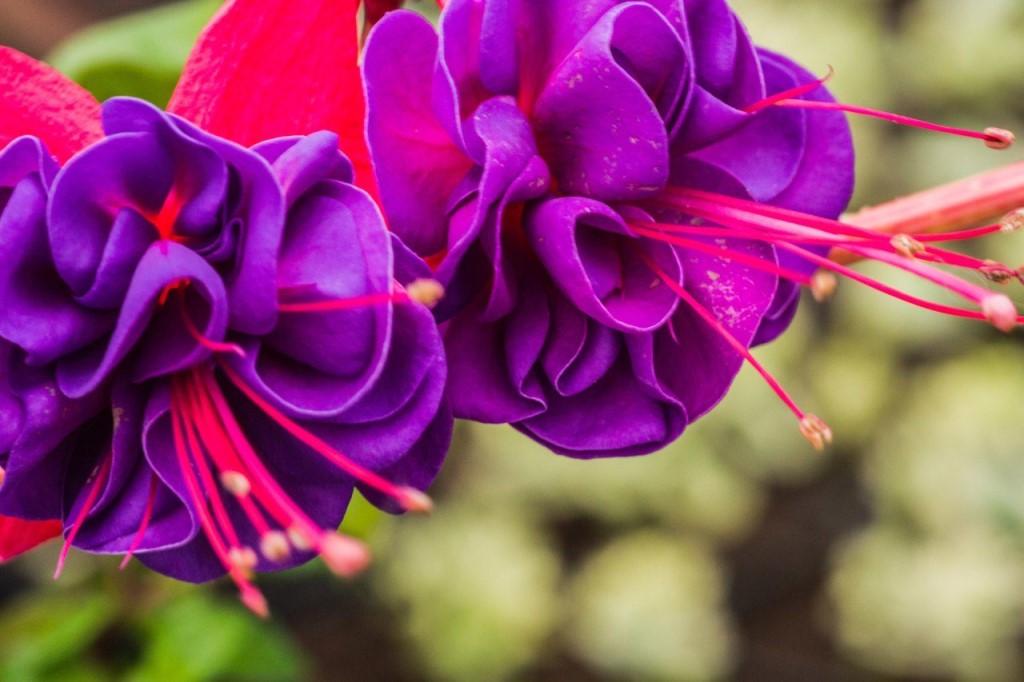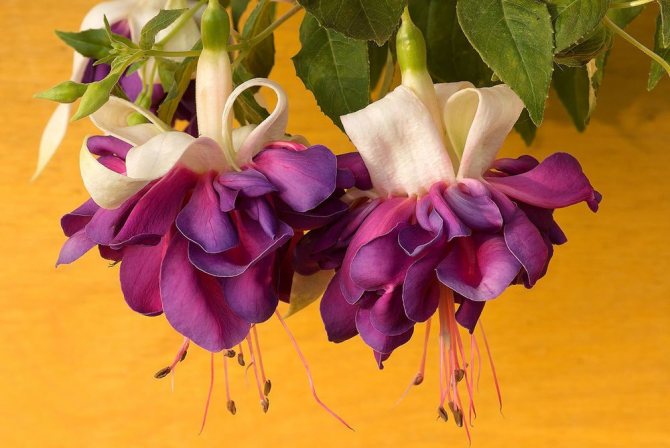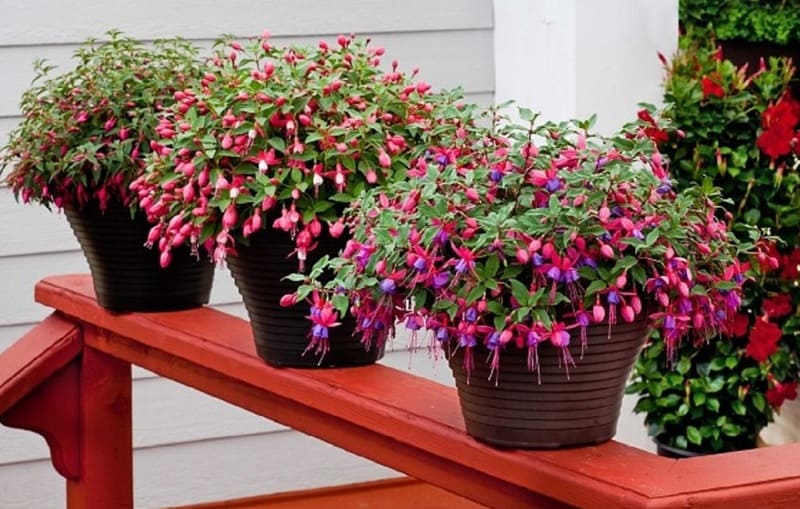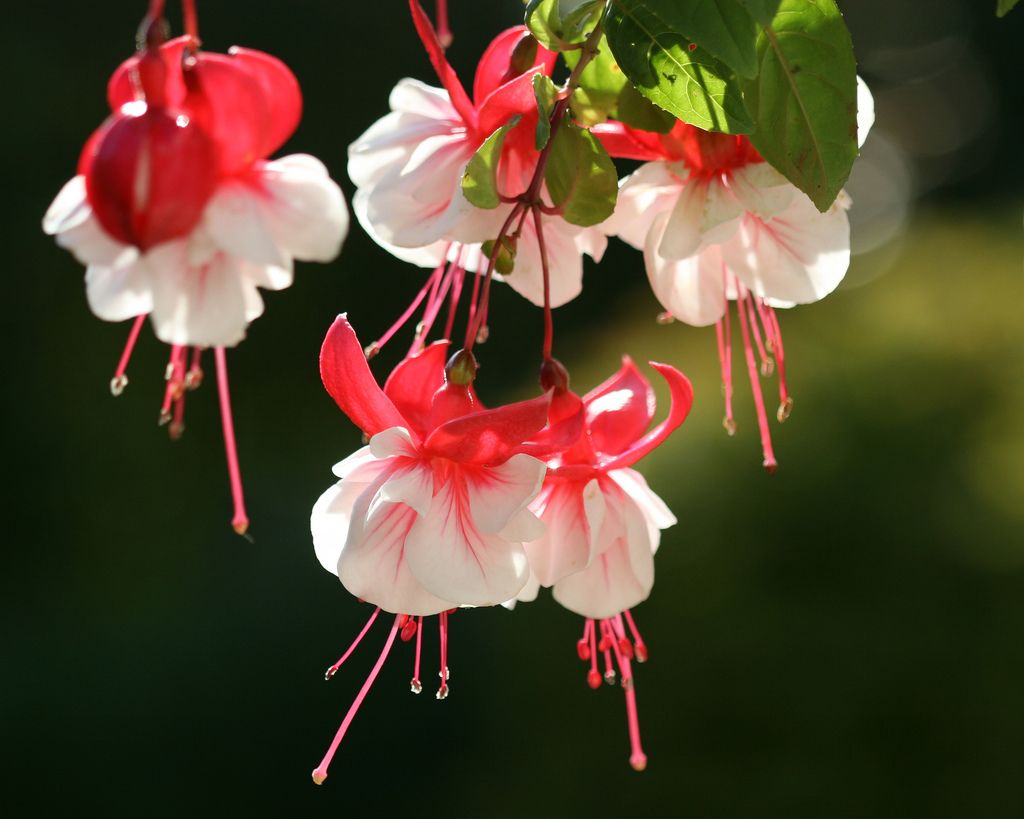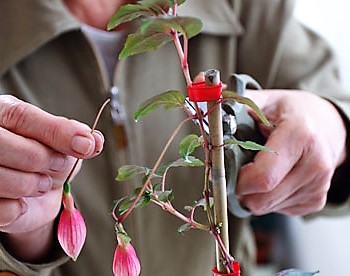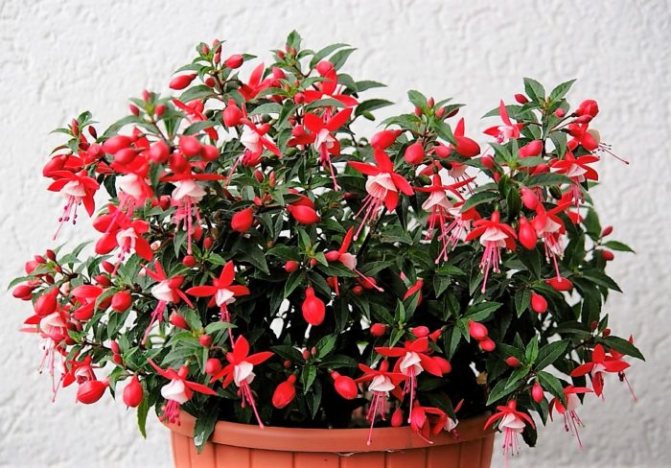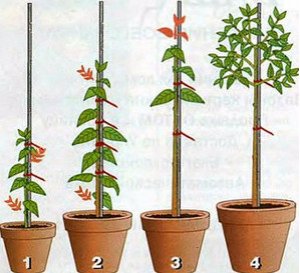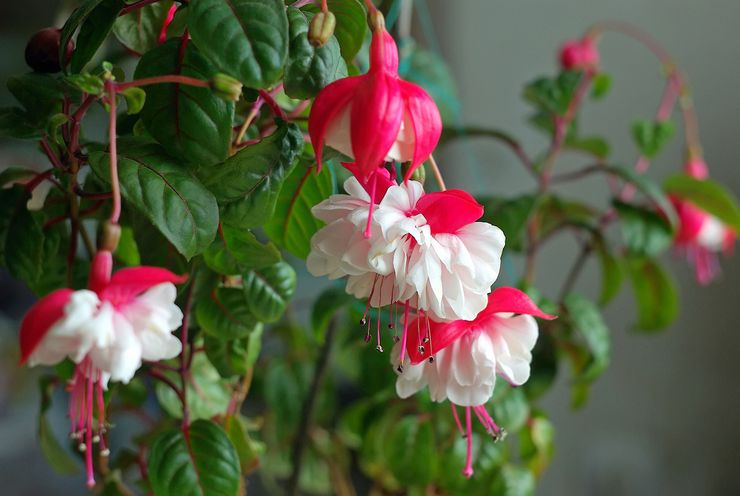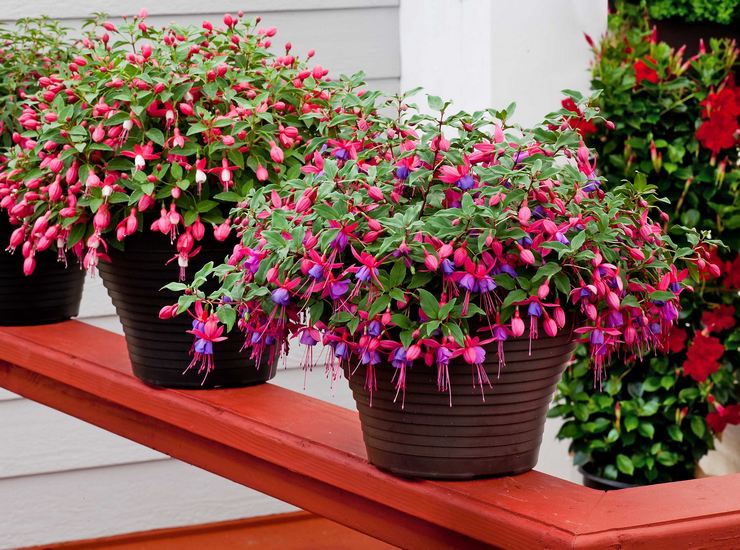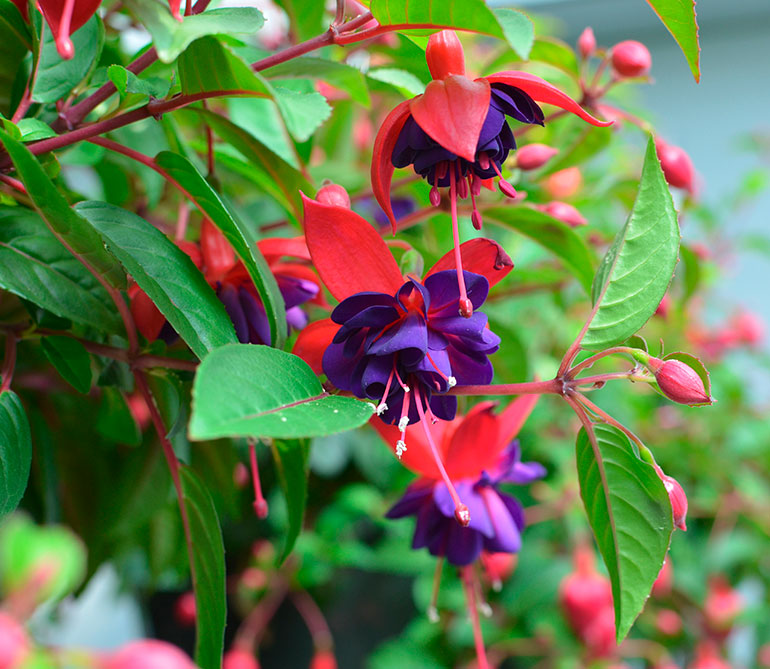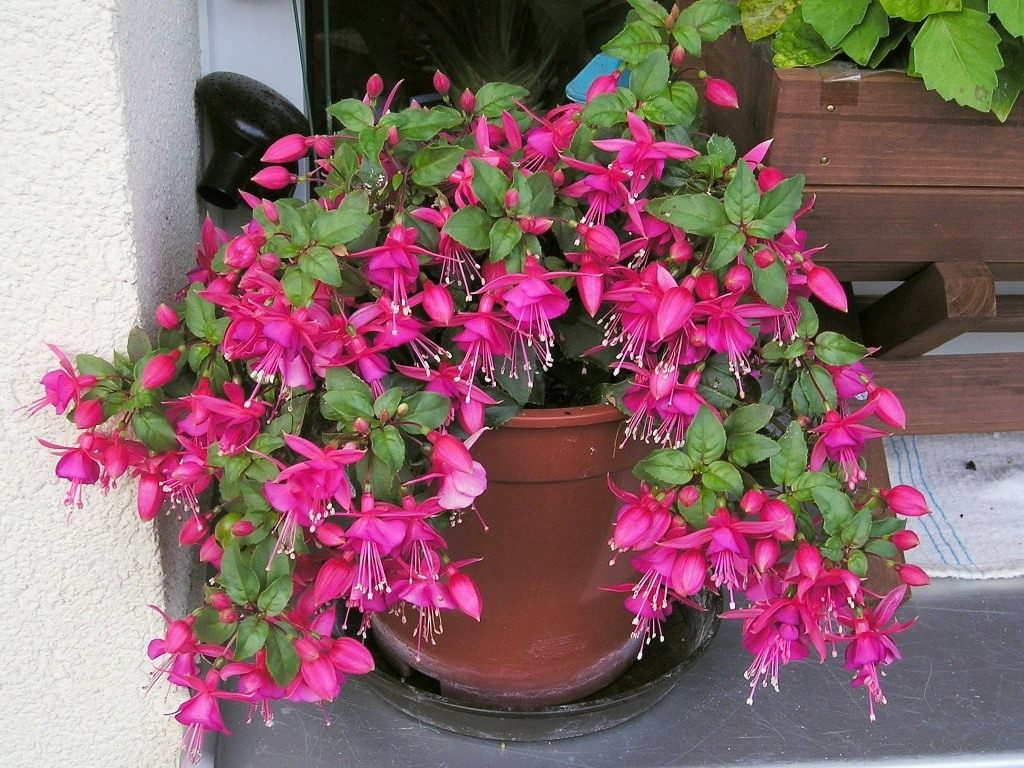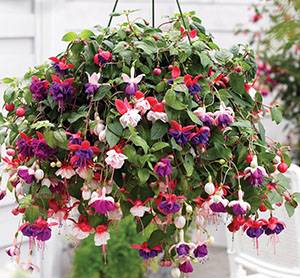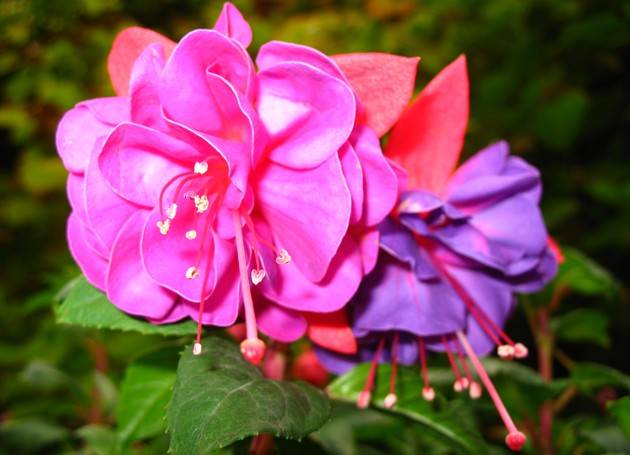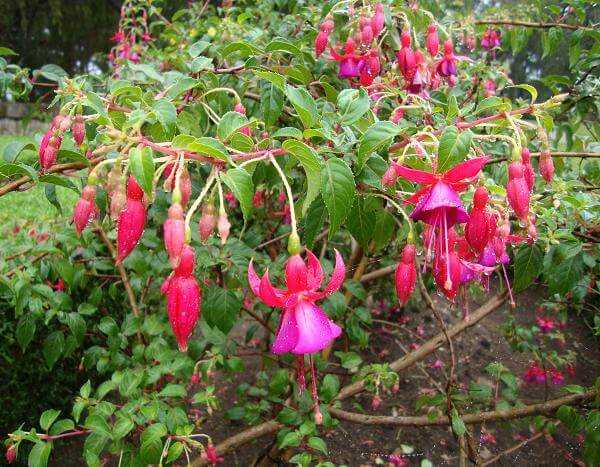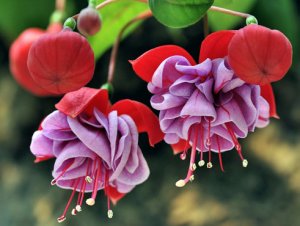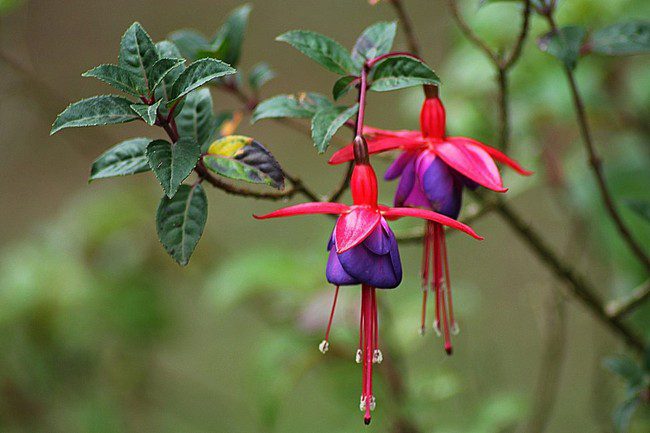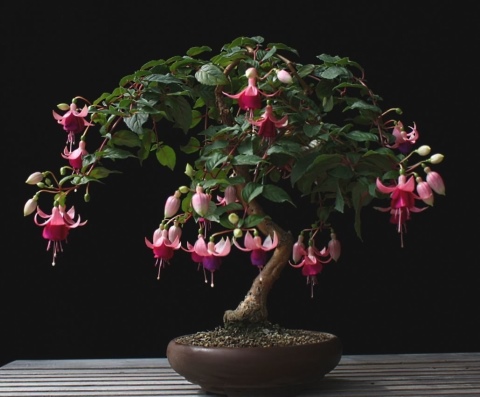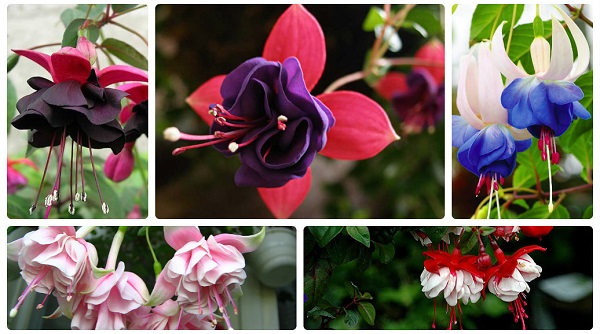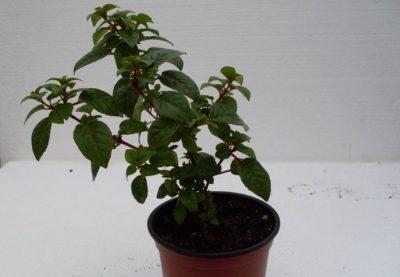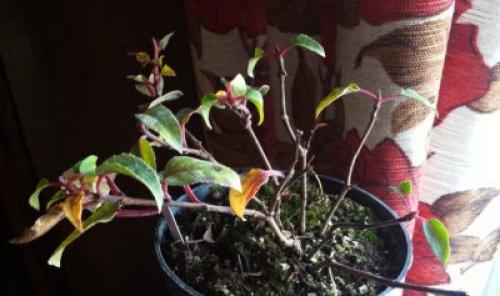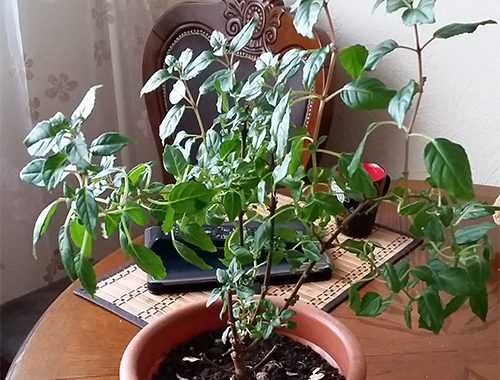Trimming and pinching
Fuchsia, which is planned to be placed in the basement for the winter, must be carefully trimmed. This should be done in the fall after flowering. In the spring, pruning is also required (dry and broken stems are removed), after which the plant is transplanted.
Spring pruning involves the following procedure:
- Removal of dry shoots.
- Undercutting long hardened stems by one third.
- Removing excess shoots to reduce crown density.
- Standard pruning to form a bush. To do this, three buds are counted from the bottom of the plant and part of the shoot is removed in the designated place.
If you neglect pruning, a small bush can transform into a rather large tree (depending on the variety, the flower can reach a height of three meters or more).
To improve the quality of flowering, it is recommended to pinch young shoots. The procedure also helps shape the bush by giving it a specific look, such as a ball or bonsai tree. To make a small tree out of fuchsia, pinching should be done in winter. The procedure consists in removing unnecessary shoots - a few pieces are left on the central trunk. If by the spring the crown has not acquired the desired appearance, re-pruning is carried out.
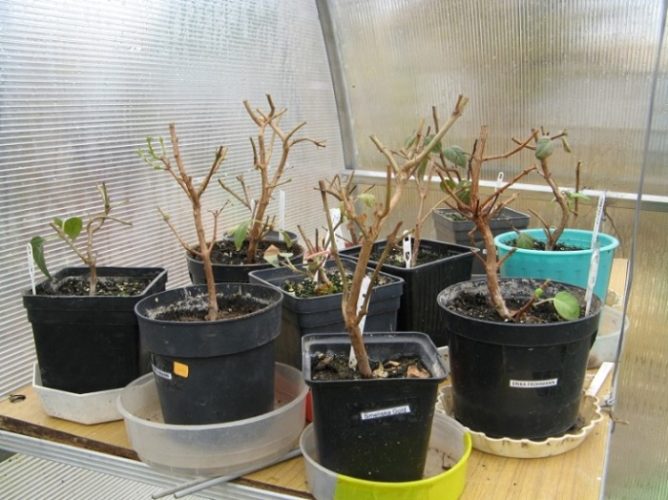
Fuchsia pruning
When pruning, it is important to take into account that the formation and development of flowers takes about two months.
Planting and caring for fuchsia
Breeders have created a huge number of fuchsia hybrids. Each of them has its own advantages. But all of them are distinguished by long-term flowering with beautiful flowers-earrings.

Different varieties of fuchsia
To make a houseplant happy, you need:
- pruning fuchsia in the spring;
- transfer;
- watering;
- fertilizer.
Spring transplanting is very important in achieving the goal. It is carried out until the plant is completely out of the dormant period. However, there are differences between transplanting a young plant and an adult bush. A young flower every spring (up to 3 years old) should be transplanted into a larger pot, and for an old bush, the old one is enough. You just need to cut the roots a little, shake off some of the soil and add fresh earth.
Note! Under no circumstances should the top of the soil be compacted. It is enough to vigorously knock the container on the table surface
After watering, you can add more soil.
Watering should be drastically reduced for a couple of days after transplanting. It would be even better to create a greenhouse effect, that is, cover the bush with a film cap.
The optimum temperature for a home flower is around 20-22 ° C. In the light and warm season, the culture blooms profusely and vigorously. In winter, 18 ° C is sufficient. During this period, new buds stop forming. There comes a period of rest.
Fuchsia reacts to strong temperature drops by dropping leaves and buds. Plant immunity decreases, which can lead to various diseases and pests.
For the full development of fuchsia, 12-hour daylight hours are enough. During the growing season, this corresponds to the eastern and northern directions. But even there they will have to be protected from direct sunlight and supplemented with a lack of light.
For your information! In summer, it is useful to take flowers into the garden in the lacy shade of a tree or shrub.
It is very important not to touch the flower during flowering. Neither rearrange nor rotate
He can easily shed the buds.
Watering a flower is an important part of house flower care. The frequency and abundance of watering depend on the drying of the topsoil. In this case, urgent and abundant watering is required. The earth ball must be completely saturated with moisture. Stagnation of water in the sump is unacceptable, therefore, after 20 minutes, the residues are drained from it.Spraying is useful to increase air humidity.
On average, watering in the warm season is carried out every three days. With the onset of autumn, it is reduced to 1 time per week, and in winter it is enough to moisten the soil a couple of times a month.
Fertilize fuchsia twice a month. Complex fertilizers for flowering plants are suitable as top dressing. In winter, feeding is not required.
Attention! When propagating, rooted cuttings are not fertilized in the first year. Fuchsia in the house is charming
It is easy to grow. There is no difficulty in breeding, even for beginners. It is very interesting to watch how fuchsia grows. If properly looked after, the abundant and long flowering of the ballerina is ensured
Fuchsia in the house is charming. It is easy to grow. There is no difficulty in breeding, even for beginners. It is very interesting to watch how fuchsia grows. If properly looked after, the abundant and long flowering of the ballerina is ensured.
vote
Article Rating
How to do a transplant in the fall at home?
With the arrival of spring, the plant wakes up, renews itself, the phase of active growth begins. All summer long, the flower is covered with graceful, bright inflorescences. And by the end of autumn, fuchsia looks tired, yellow foliage, part of it is crumbling, flowering has stopped. Preparations for winter holidays begin (read here how to preserve fuchsia in the basement and in the apartment in winter). Gradually reduce watering, stop fertilizing the soil.
In the fall, the plant is pruned, removing dry, weak shoots that thicken the crown. This will give the opportunity to form new foliage. During this period, it is not recommended to seat. Indeed, after transplanting, the flower will begin to grow, and a short daylight hours, lack of lighting can play a cruel joke. The shoots will stretch out, become weak and long.
You can resort to artificial lighting, but this, most likely, will not be enough. The plant is exhausted for the entire season, rest is extremely important for it.
Advice! The best option is to postpone the fuchsia transplant until spring arrives, and put it in a cold place for the winter.
Our experts have prepared other articles about the nuances of growing fuchsia in the garden, as well as interesting facts and signs about this flower.
Do I need to pinch fuchsia
The formation of fuchsia at home is a rather fascinating and interesting process, since the crown of a plant can be given almost any shape. There is only one way to do this - by pinching. And this process is mandatory, since it is thanks to it that additional lateral shoots are formed with buds located on them, which, as a result, bloom. This simple procedure helps the plant to bush even more and acquire more lush flowering stems.
If it became noticeable that the plant was crushed, additional shoots did not appear on it, pinching of fuchsia must be done. Due to the procedure, the flower will revive, it will have more incentive to grow, and after a short period of time a much larger number of buds will appear on it than it was before.
Important! Many fuchsia varieties do not branch out on their own and grow like a flower on a stick. And only pinching is able to force the plant to bush and help the formation of new lateral shoots with buds.
How to pinch fuchsia at home
To carry out the procedure, one of two main methods is usually chosen. The classic version of fuchsia pinching:
- with each procedure, the growth point is removed from the flower, this contributes to the fact that the size of the plant doubles, and with it the number of flowers;
- for the first time, for fuchsia, the cultivation of which begins from a cutting, it is necessary to carry out three pinching procedures. It'll be enough;
- the formation of the crown of fuchsia may take time - 2-3 months;
- flowering will occur after the establishment of a long daylight hours in the apartment, not earlier than 2 months after the last pinching procedure.
The second option for pinching fuchsia at home is K. Dave's method. It is based on the property of the plant itself to double the number of new shoots without new internodes. With its help, a lush plant is formed in a relatively short time.
Since the number of growing shoots is large enough, it should be used with caution, there is a risk that the stems will break under the weight of the flowers
The plant can be pinched at any time of the year, it is especially important to do this in winter to avoid pulling the stems out during the rest period. If you figure out how to pinch fuchsia, everything will work out
Important! There is no single rule on how to pinch plants. There is no right or wrong process of crown formation, it all depends on what effect you want to get in the end
Crown formation
To form the crown of a standard tree, the easiest way is to use upright varieties. In the first step, it is recommended to tie them to a solid base until the shoots are more resistant. You can also use ampelous varieties, the effect will be amazing, but this will take more effort. The main stem must be tied to the peg in several places. Once the plant reaches the desired length, the growth point must be pinched to form side shoots. This is how the crown will form. After completing this process, you can remove the support peg.
The formation of ampelous fuchsia consists in the removal of growth points for the formation of new lateral shoots. Initially, you need to let the main stem grow to the desired length, and then start pinching.
Formed crown of ampelous fuchsia
Growing, reproducing and transplanting a flower
A flower transplant should be done annually. This will update it so that the overgrown root system has a lot of space. Use a medium-sized, light-colored ceramic pot for replanting. The reason is that during the heat in a plastic container, the soil quickly warms up, and the heating of the roots contributes to the dropping of the buds.
As for the soil, fuchsia does not impose special requirements, but it is best to use a soil composition obtained from such components: deciduous soil, peat and sand (3: 2: 1).
Important! You should definitely take care of drainage. To do this, put expanded clay on the bottom of the pot.
This will prevent damage to the root system and accelerate flower growth. Before transplanting fuchsia, cut 1/3 of the length of all shoots
Do not transplant the plant, but it is better to transfer it together with a lump of earth, and fill it with soil around the edges. This will prevent damage to the root system and accelerate flower growth. Before transplanting fuchsia, cut 1/3 of the length of all shoots.
As for the reproduction of fuchsia, it can take place by seeds, cuttings and leaves.
Seeds
This method is not so popular. The reason is that in order to obtain seeds, the plant must be artificially pollinated, then harvested. In addition, the seed method will not allow you to get a flower with precise varietal characteristics.
Cuttings
This method is the simplest and most popular one. Procedure:
- Cut the cuttings in spring and autumn. Their length should be approximately 7 cm.
- Place the cuttings in a humid environment. This can include a glass of water or damp sand.
- After 3 weeks, roots are formed. This is the best time to transplant the plant into the ground.
- Use small pots or disposable cups for cuttings.
Next, you can watch a video where you will see the propagation of fuchsia by cuttings:
Sheet
This method is also simple and fast.It is necessary to rip off the strongest leaf, set it in a loose and moist substrate by 1 cm, cover it with a jar on top. As soon as small shoots are formed, then transplant the plant into a larger pot.
Seed propagation
If you propagate fuchsia by seed, you will have the opportunity to feel like a breeder and get your own plant variety. As you know, the samples obtained from seeds lose the characteristics of the parent plant and acquire their own.
First, eliminate any pollination. Cut off the stamen from the still closed flower, pollinate the pistil with the pollen of the parent plant and put a cotton or paper cape on the flower to protect it from insect interference. Carefully open the swollen ripe fruit, remove the seeds and dry them.
The resulting seeds are placed in wet soil and sent to the greenhouse. After ten days, it will be possible to observe the first sprouts, after one and a half to two months it is necessary to dive, and after two more, the strengthened seedlings are placed in their pots.
Fuchsia propagation
Fuchsia from seed
Cross-pollination is required to obtain seeds. Pollination is best done in early summer. The pollen of the father fuchsia plant is applied to the stigma of the pistil. Next, you should isolate the flower by putting an insulating bag on it - this will prevent accidental pollination by insects. An insulating bag can be made from improvised means - paper, fabric, fastened around the flower with threads.
Fuchsia fruit ripens for several weeks. When ripe, most of the fruits are dark red, some are dark green. To determine whether the fruit is ripe or not, we lightly squeeze it between the thumb and forefinger: if it is soft, then it is ripe. Seed germination strongly depends on the completeness of ripening of the fruit on the plant. Plants obtained from seeds rarely repeat their parental qualities.
The fuchsia fruit is carefully cut in the longitudinal direction and the seeds are removed, which are in a jelly-like substance. Using a knife, carefully separate the seeds from the pulp. Dry them for a week. Drying is required, otherwise the seeds may become moldy and lose germination. Store in a paper bag in a cool, dry place.
The optimal time for sowing seeds is March - April. Before sowing, they are soaked in warm water for 24 hours. Sow over a slightly moistened substrate. The seeds should not be buried, they are simply pressed in. Above the crops, using a sprayer, are moistened with a weak solution of potassium permanganate. The seeded containers are placed in a greenhouse. The optimum temperature for germinating seeds is 25C. Lighting - diffused sunlight. Fuchsia seed shoots will appear in about two weeks. Germination is random: from several days to several weeks. From this moment on, the seedlings are regularly aired twice a day. The substrate should not dry out - watering either bottom, or using a sprayer. After the appearance of the second pair of leaves, the seedlings dive, planting them one by one in a 100 ml disposable cup (do not forget about the drainage hole). After two months, the plants are transplanted into 200ml cups. Before young fuchsia plants are removed from greenhouses, they must be gradually accustomed to normal air humidity. Unadapted fuchsia seedlings can be severely damaged and even die if adaptation is neglected.
Fuchsia propagation by cuttings. Rooting in the substrate
Cuttings used for propagation must be free of flowers. Take cuttings from healthy plants, you should not take from dying ones. The optimal time for grafting is March. Avoid using for propagation of plants with pests and diseases, especially with rust.
Required tools and materials:
a sharp knife or garden shears;
disposable cups (200 ml) with drainage holes made in them;
soil substrate - vermiculite or a mixture: 1 part of leaf land + 1 part of sod land + 1 part of perlite;
root formation stimulant.
1) Using a knife, cut off the cuttings (stems without flowers). The leaves on the handle should be dark green; cut below the base of the leaves (internodes).
2) Sprinkle the cut with growth hormone (stimulant).
3) On the cut cuttings, remove the lower leaves, leaving only a couple of healthy ones.
4) Pour the substrate into the glass.
5) Holding the handle with your fingers, immerse it in the glass so that the cut does not touch the bottom. The stalk should be in the center of the cup, the leaves on the stalk should not touch the soil.
6) Water the substrate.
7) Put the cups with cuttings in the greenhouse. Rooting time 2-3 weeks.
Conditions for keeping cuttings during rooting:
temperature: 20 ° C;
illumination: diffused light.
After rooting (the roots have reached 2-3 cm), the cuttings are transplanted into a mixture for an adult plant.
Fuchsia propagation by cuttings. Rooting in water
The breeding season is from spring to late autumn.
For cuttings, ripe, but not yet lignified shoots are used. Cuttings with a length of 8-10 cm are cut from them. One pair of leaves is left, treated with a rooting stimulant. Prepared cuttings are placed in a disposable cup filled with boiled water.
Rooting conditions:
temperature: 20 ° C;
illumination: bright diffused light.
Rooting time: one to two weeks.
Light in plant life.
Seasons in plant life.
Light hand magic.
Plant quarantine.
How to prune and preserve the plant correctly?
Before wintering, fuchsia is cut off, not fertilized and sprayed with a biological product purchased from a flower shop to protect against pests.
Basement or cellar
How to keep a plant in the basement, and what kind of care is needed? Not everyone has the opportunity to organize the wintering of fuchsia on a warm glazed loggia of an apartment or in a bright greenhouse. Wintering goes well in a "dark" room - in a basement, garage or cellar. Before moving it to one of the rooms listed above, cut it, remove the leaves.
In the dark, it also "breathes" as in the fresh air, consuming nutrients and evaporating water. There must be ventilation in the room where it will be located. Otherwise, with its appearance in it, the humidity in the air will increase, which will provoke an outbreak of fungal diseases. The optimum temperature for wintering fuchsia in a cellar or basement, where the temperature is - + 10⁰С.
Watch a video about how fuchsias winter in the cellar:
In the apartment
Not all growers have a basement or garage where you can move a fuchsia pot for the winter. Some have no choice but to bring it home. It is also possible to provide a comfortable wintering in the apartment, but only if it is regularly ventilated.
At the beginning of autumn, cuttings of fuchsia are transplanted into "poor soil" with a small amount of humus for the winter. This slows down the growth of young bushes. If in winter the grower notices that they are sprouting, he must mercilessly cut them off and open the window wider to lower the temperature in the room. The scions do not need to be thrown away. You can try to root them by placing them in water on a well-lit and "warm" windowsill.
If the fuchsia wintering in the basement is rarely watered - 1-2 times a month, then the plants that winter in the apartment are watered more often.
Note! Due to central heating, the earthen clod dries out faster, and the lack of moisture leads to the death of the flower.
On the day when the florist brings the fuchsia pot home, he must open the window and set the glass unit to the minimum ventilation mode. The window should always be open, except for days when it gets very cold outside.
During the rest period, fuchsia is even more capricious than during the period of active growth and flowering. It reacts poorly to excess and lack of moisture.Lack of necessary conditions for wintering, high air humidity and temperature lead to the appearance of insects. Fungicides and insecticides do not always help in the fight against them, and the plant can only be thrown away.
How to care for a flower on a windowsill?
- Maximum ventilation of the window sill. The pot is placed as close as possible to the glass.
- Warming the bottom with foam during transplanting helps to avoid root rot due to cold masses constantly bursting into the room through a slightly open window.
- A dry air fence will be needed if the apartment is hot. To do this, simply cover the fuchsia with plastic wrap.
- Watering should be infrequent and not plentiful.
- The plant must be treated with special preparations to protect it from pests.
- In December and January, the plant is illuminated with lamps, since there is insufficient lighting during the day.
Watch a video about the problems of fuchsia room wintering:
You definitely need to cut the plant for the winter, because this is an important stage in growing and it is very important to do it right. It is held twice a year.
The first time is in the fall, when it is transferred from the garden to the basement or apartment and it is necessary to provide suitable conditions for hibernation for it, and the second - in the spring, in order to form a beautiful bush. Fuchsia is cut in the fall after it has faded, so as not to provoke the growth of 1-2 trunks and pulling up the bush. This procedure is necessary for the correct development of the flower next spring.
Room fuchsia care
There are many varieties of fuchsia, but the most common indoor fuchsia is Fuchsia hybrida. It is she who can most often be found in our apartments.
Lighting
Indoor fuchsia is a rather unpretentious plant, loves full lighting, but at the same time it is advisable to shade it on hot summer days. It is better to keep it on windows facing the east or west side. With a lack of lighting, fuchsia shoots stretch out, which does not look very attractive.
Temperature
For abundant flowering of the plant, the optimal temperature in the room should be at least 20 degrees; after flowering during the rest period, fuchsia is best kept in a cool room at a temperature of 10-14 degrees.
Watering fuchsia and moisture
On summer days, the plant should be watered twice with settled, soft water. In the spring-autumn period, watering is reduced to one time. In the winter months, the land should dry out completely between waterings, during this period it is better to water the fuchsia once every two weeks. When watering the plant, do not forget about the humidity of the air. This has a beneficial effect on the duration of flowering. If the weather is hot, dry, then you can spray indoor fuchsia twice a day; in cooler times, twice a week is enough. In winter, the plant does not need to be sprayed.
Fuchsia substrate
Don't forget about the condition of the soil. The easiest way is to buy ready-made primer in a specialized store. But if you decide to prepare the soil for your favorite plant yourself, know that homemade fuchsia loves soil containing peat, rotted manure, leafy soil, sand and alumina in equal parts.
Transplanting and pruning fuchsia
In early spring, start transplanting indoor fuchsia, but first cut its twigs to the stiff part of the stem. This will give the flower a more compact and beautiful shape in the future. Choose a pot one size larger than the previous one and always with drainage holes. Do not forget to put a layer of expanded clay on the bottom.
Fuchsia propagation
After pruning the plant, do not discard the cuttings. New plants can be obtained from them, since indoor fuchsia propagates by cuttings and seeds. Remove the lower leaves from the cuttings, leaving no more than 3-4 upper leaves, and place them in water or wet sand. For good rooting, keep the temperature at least 20 degrees. Spray the cuttings periodically, and change the water. The plant usually takes root after two weeks.After that, the cuttings are planted in pots with ready-made soil mixture.
Fuchsia feeding
As soon as buds appear on room fuchsia, fertilization should be started. It is enough to water once a week with liquid fertilizer for flowering plants, diluted in accordance with the instructions. At the beginning of autumn, feeding is stopped. Do not forget, fertilizer is applied only to wet soil!
Fuchsia diseases
Indoor fuchsia is very rarely subject to disease. If the humidity is very high, powdery mildew may appear or the roots may start to rot. With a strong overdrying of the soil, leaves and buds fall off. Also, dropping of buds can cause rearrangement of the plant from place to place and drafts.
Indoor gerbera Indoor trees: care, choice, features
After this article, they usually read
Add a comment
Care features
In the fall, many fuchsia varieties are harvested from the street to store in optimal conditions until spring arrives. If you grow a perennial at home, you should know that having found a suitable place for a flower, it cannot be moved and moved. This can result in foliage shedding, reduced growth, and cessation of flowering.
Watering
In spring and summer, the plant loves frequent and abundant watering, and in autumn and winter it is reduced.
It is important not to flood the root system and not to provoke its decay. It is necessary to moisten the soil when its top layer dries out.
After watering, drain all excess water from the pan. In the heat of the flower, along with watering, you can arrange irrigation in the form of a shower.
In summer, fuchsia is watered once every 3 days, and if the weather is hot, then watering is performed every other day. Closer to autumn, the watering regime is reduced and they do it 1 time in 7 days. It is better to water the plant in the morning or in the evening, at sunset. The plant is hygrophilous and does not tolerate both waterlogging and a long anhydrous period.
Pruning
A perennial should be pruned often, a haircut will stimulate its growth. Pruning is understood as the pinching of the tip of the shoot. This measure allows the plant to form many lateral shoots. A young seedling should be pinched 2 weeks after planting in a pot. Then the pinching is performed every spring - until the moment when the plant begins to bloom.
To create a standard tree, seedlings are planted densely and close to each other, while regularly breaking out all the side branches and flower buds from them. They continue to do this until the plant reaches the desired height, and then pinch the top growth point
During the growth period, it is important to feed the plant with nitrogen.
Reproduction
Fuchsia is propagated by cuttings or seeds. It is quite easy to grow roots for cuttings, and planting material appears in abundance during spring pruning.
Propagation by cuttings
Cuttings in the form of shoots with 2-3 internodes are suitable. To ensure that the cuttings get more moisture, the leaves are cut in half. Large leaves with a dormant bud can also grow roots when placed in water. To accelerate the growth of roots, cuttings are treated with the Kornevin stimulator.
When the stalk gives roots, it is planted in a pot with a diameter of 9-10 cm. The planting is done in moist soil - they take a mixture for adult fuchsias and half dilute it with sand or perlite. The planted cuttings are placed at a temperature of 20-22 ° C and provide diffused sunlight. From above, the planting is covered with a film, but once a day it is removed for a couple of minutes for airing. After the appearance of the leaves, the cuttings are planted in a permanent place.
Seed propagation
The seeds are placed in a germination container, where a sterile soil is prepared. Sprinkle with a thin layer of soil and cover with foil. They are placed in a warm and bright place, and after 2 months shoots appear. After the seedlings grow 2-3 pairs of leaves, they are dived and grown in separate containers.
When growing seedlings, it is important to monitor the soil moisture and, if necessary, moisten it with a spray bottle
Problems and illnesses
With improper or irregular care, various problems occur with fuchsia. For example, a plant throws off leaves and buds, its flowers become smaller, or in spring the plant does not bloom, but gives only foliage. It also happens that its branches suddenly become stiff, dry up, or they have a white coating.
Excessive application of nitrogen to the soil can also adversely affect the flower, if at the same time a sufficient amount of phosphorus-potassium components has not been added. Violation of this balance forces shoots to grow, but leaves roots and buds without movement in growth.
Sometimes rotting roots can be the cause of disease. In this case, they need to be cut off, the cuts should be powdered with coal powder, the plant should be placed in a container with water, and when it has new roots, the flower should be transplanted into another soil.
In addition to mistakes in care, fuchsia can be affected by a whitefly, and then the plant becomes covered with rusty spots, and the leaf plates twist inward and fall off. This insect appears when the air humidity is high. For treatment, spraying is stopped, damaged stems are removed and the flower is treated with insecticides.
Fuchsia can be attacked by spider mites - a thin cobweb appears on the shoots, the plant throws off the foliage and withers before our eyes. It can be cured by removing the affected parts and spraying with insecticidal preparations. Follow the instructions.
Common fuchsia diseases are gray rot, with the appearance of mold spots on the leaves and shoots, as well as viral rust, which manifests itself in the form of red spots.
Wintering fuchsia in the open field. Pruning rules for the winter
In most cases, gardeners are advised to dig up fuchsia for the winter and leave it in pots indoors or at home, since this is not so difficult to do. So it will be possible to protect the tree from frost, keeping it warm. If the bushes have already reached rather large sizes or there are a lot of them on the site, they will not be able to be stored indoors. In this case, you can simply cover the plants with spruce branches, spunbond. They should spend the winter well. Some varieties need to be cut almost below ground level, abundantly cover from above, sometimes even sprinkle 10-15 cm with earth. At the end of spring, the plants are dug up, after which they begin to grow again.
Note! Annual varieties of fuchsia can not be left for wintering, instead, every year you will have to make a new rooting of cuttings
Reproduction of a flowering plant
Abundantly blooming fuchsia can be propagated by green cuttings, seeds and leaves. Let's take a closer look at these methods.
Cuttings
If the choice fell on fuchsia cuttings, then 5-8 cm of stem cuttings are chosen for these purposes. They are planted in several pieces in containers with a diameter of about 12 cm. Next, the pots should be placed in a small greenhouse for subsequent germination.
Cuttings are often rooted using water with the addition of activated carbon. The pots are covered with a film on top, from time to time removing it for airing. To plant the cutting, you should wait for the formation of roots in the size of 1.5-2 cm.
We recommend watching a video about fuchsia cuttings:
Seeds
When propagated by seeds, fuchsia germinates approximately 50 days after planting. First you need to prepare a suitable soil by mixing peat and sand. After a month, the grown plant should be dived. How to plant seedlings? They are planted in pots of 5-6 pieces, not forgetting to first pinch the top to improve branching.
Leaves
When propagating with the help of leaves, the most developed leaves with a stem are removed from the mother plant and planted in soft soil, covered with a film on top.
Care
Thanks to the work of breeders, fuchsia varieties have appeared that winter on the street even in those regions of the Russian Federation where the temperature on the thermometers drops below -30 degrees Celsius.Before thinking about organizing her wintering, learn winter hardy she or not.
Important! You cannot bring winter-hardy fuchsia into the apartment: it feels in natural conditions - it is better in the garden than in the warmth.
Care for fuchsia in winter is easy. It is not necessary to fertilize it, but only to water it as the earthen coma dries up. It is advisable to maintain the temperature on the windowsill - + 10-15 degrees Celsius. It allows you to stop the growth of the plant until spring. A bad place for him is the north window, since due to an acute lack of light, it stretches out. The best time to "wake up" is the end of February. A winter-hardy plant is left in the garden (varieties Coralline, Baby Blue Eyes, General Monk, etc.).
Before wintering, they cut it off, leaving shoots 5-10 cm long. If it grows in a hanging flowerpot, take it out and transplant it into a pot or open ground with a small content of humus. For wintering, fuchsia is covered with a layer of peat or dry oak leaves. To protect it from moisture, a layer of polyethylene film is laid on top of it.
Cutting features
Choosing the season: when is the best time to start?
First you need to decide when it is best to prune fuchsia. Most often, this process is performed in the spring. It is worth pruning before new buds are formed. Thus, the flowering will become lush and long lasting.
Can this be done in the fall and winter?
You can carry out autumn pruning of fuchsia, but only do it in late October - early November. This option is suitable for those florists who grow fuchsia as a houseplant (read about the nuances of growing fuchsia at home here).
Pruning in the fall takes place in a gentle mode. On each branch, remove those parts on which the peduncles were. Cut off the twigs to the first pair of stone buds from the top. When fuchsia still continues to bloom in the fall, it is better not to touch it, but to postpone this matter until winter.
Carry out winter pruning for those plants in which flowering lasts until late autumn. In addition, winter pruning must be done before sending a flower for wintering (read about how to keep fuchsia in the basement and apartment in winter here).
Pruning should be strong, leaving shoots 15 cm long. If the crowns are already formed, then remove only weak shoots, thin out and shorten the remaining branches by 1/3 of their height. Subsequently, to form a standard tree in specific places, the shoots are pinched.
Instrument and disinfection
Use a sharp knife or garden shears to trim fuchsia. Before starting the process, one of the important points is the disinfection of garden tools. This will prevent the development of viral diseases, the transmission of which occurs with the sap of affected plants.
In the process of disinfection, various compounds are used that contain alcohol. You can use alcohol-containing wipes, medical sprays or household products: chlorine, kerosene.
Advice! Permanganate vitriol (5-10%) has a disinfecting effect. Dip the tool in such a solution for a few minutes, and then wipe it with a clean cloth.
For lush bloom
It is from pruning that the intensity of flowering depends. The later the procedure is carried out, the later the fuchsia will begin to bloom. It is desirable to carry out pruning 2 times a year - before wintering and in early spring. Autumn pruning is preventive in nature, since in its process damaged, frail and thin twigs are removed.
Spring pruning is done in February-March. Its main task is to form a beautiful crown with a large number of young shoots, at the ends of which buds are formed.
The pruning process has the following features:
- The first step is to remove the small frail twigs. On them, most likely, there will be no flowering, and if it does, it will be very weak.
- Now you can move on to removing dry and very thin twigs.
- Cut off those shoots that are directed to the center. This will prevent the bush from becoming too thick.
- When pruning shoots, take into account that the crown is of the correct shape. Make a cut at a distance of 1.5-2 cm from the node.


